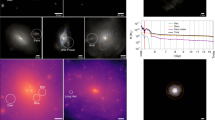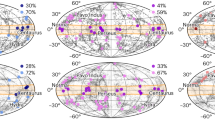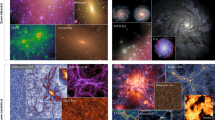Abstract
IT was suggested recently that, if mesons are bound states of nucleon–antinucleon pairs, there might be a spatial separation of matter and antimatter in the black-body radiation above a critical temperature of about 350 MeV 1 leading to the production of separate condensations of matter and antimatter. Some approximations made in that work have been removed recently by using the work by Dashen Ma and Bernstein (Institute for Advanced Study, preprint, 1969) on the statistical mechanics of elementary particles (also my unpublished work). The sizes of the condensations have also been computed in the latter paper as D0 = 10−6 cm at the end of the critical period (kT = 350 MeV) in the Lemaître–Gamow universe2. Their density is then of the order of the nuclear density.
This is a preview of subscription content, access via your institution
Access options
Subscribe to this journal
Receive 51 print issues and online access
$199.00 per year
only $3.90 per issue
Buy this article
- Purchase on Springer Link
- Instant access to full article PDF
Prices may be subject to local taxes which are calculated during checkout
Similar content being viewed by others
References
Omnès, R., Phys. Rev. Lett., 23, 38 (1969).
Alpher, R. A., Gamow, G., and Herman, R., Proc. US Acad. Sci., 58, 2179 (1967).
Klein, O., Nature, 211, 1337 (1966).
Author information
Authors and Affiliations
Rights and permissions
About this article
Cite this article
OMNÈS, R. On the Origins of Galaxies. Nature 223, 1349–1350 (1969). https://doi.org/10.1038/2231349a0
Received:
Issue Date:
DOI: https://doi.org/10.1038/2231349a0
This article is cited by
Comments
By submitting a comment you agree to abide by our Terms and Community Guidelines. If you find something abusive or that does not comply with our terms or guidelines please flag it as inappropriate.



